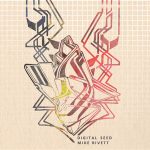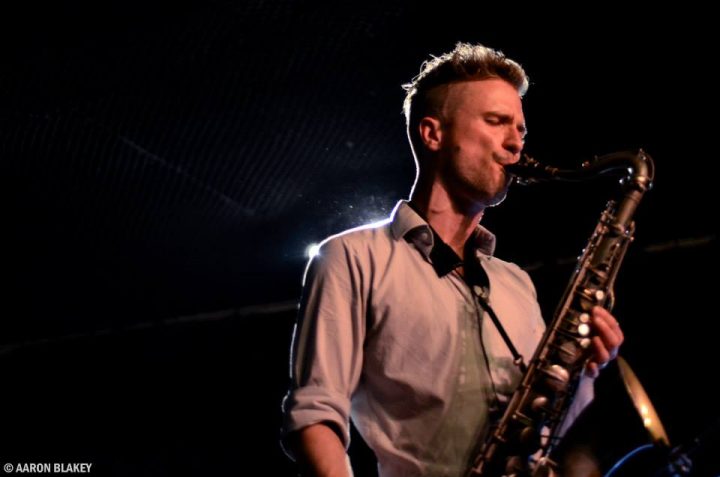I still like music without words. Words are of us, but music can be more.
An interview with Mike Rivett for Jazz Australia.

JA: How did you first get interested in music and taking up the saxophone?
MR: My earliest memories of music are of my dad playing acoustic guitar and singing. He always sang with lots of soul and he used to escape into the music. He probably would have been a great musician but it wasn’t to be. My folks were always very encouraging and they bought a piano for the house so my brother and I could learn.
I started playing the piano when I was 7, and did a little bit of classical training. Then when I was 10, I picked the saxophone because I thought girls would dig it. I grew up in the 80s, you see. However, by the time I could play it reasonably well, it was the 2000s and it seemed that being skinny and having a long beard was sexier than the saxophone. Luckily, by this point, I had developed a proper love for the sound of the saxophone and got addicted to the meditation of working on that sound. It was my mum who taught me how to meditate and to strive to live in the present moment. I think this is a massively important part of playing music.
JA: You have obviously developed diverse musical influences over the years – can you elaborate?
MR: True. I like lots of different kinds of music. All the various styles serve different purposes. I grew up in Cairns and was really into Nirvana when I was in primary school. That music really got stuck inside me. I listened to it all the time. I liked Guns and Roses too. My friends and I would bmx around the back yard singing along to “Get In The Ring”. I mention that, because I remember being really passionate about that music. That’s when the fire was lit. When I was in high school, a friend of mine played me some early psychedelic trance on tape. I’d never heard this before and it blew my mind. I thought that it sounded like it was from outer space. Listening to it made me thing of being more than human or something. This is part of why I still like music without words. Words are of us, but music can be more.
Sometimes we would go to these massive dance parties in the rainforest and dance all night; the music helping us throw our bodies around in delight. It wasn’t just about dancing though. It was about brotherhood and love and all that hippy stuff.
As well as delinquent forays in the rainforest with hippies and trance music, I was also working hard at classical saxophone during the week. I did my AMEB classical studies under the knowledgeable Bob Favell (saxophone) and Lizanne Smith (piano). Those teachers set a standard of expecting excellence and hammered some discipline into me. It was fun too, but not in an Xbox kind of way. I liked the sense of achievement and I liked the logic and beauty in the music.
JA:Can you tell us a little about your Music Degree at the Manhattan School Of Music and the teachers you worked with?
MR: My good friend Andre’ Houghton showed me a CD of George Garzone’s when I had just finished high school. It was “Fours and Twos”. To me this was the coolest thing I had ever heard and I had to go and find George and learn about what he was doing. I went to America for him. He happened to be teaching at Manhattan School when I was looking at schools, so that’s where I went. Another massive draw card for me was David Liebman. Lieb and I have had a special connection since I met him at the Sydney Con years ago. It’s like we are both warriors, similar spirits or something. So it was great to learn about his energy and how his mind works. He is also really big on the art of teaching. He would say things at the start of his lectures like,
“Don’t just absorb the material, pay attention to the delivery. When am I stern and serious? When am I funny? When do I whisper? When do I formalize and when do I go all “street n’ s#*t?”
JA: You have spent some time living and playing in Tokyo. What was that experience like and how was the experience playing with Japanese musicians?
MR: Living in Tokyo was a really happy time in my life. I was living with my now wife, Megumi. It was in Tokyo that we really formed a special bond. I taught English enough to pay the bills. This meant I didn’t have to do a hotel gig 6 nights a week. Instead, I got to be part of the Japanese underground jazz scene and met some really cool, inspirational cats. Most importantly, Ko Omura, Koichi Sato, and Hiroshi Ikejiri. These cats form “Bungalow”, a band I tour with in Japan every year
JA: You will be performing your Digital Seed at SIMA’s Winter Jazz series. The Sydney Morning Herald described it as “sounding like no other album”. Can you tell us a little about the album and the music it encompasses?
MR: Digital Seed was massively inspired by Kurt Rosenwinkel’s “Heatcore”. I think that was a really special tendril of jazz-fusion. It maintains the woodiness and the organic character of jazz, but adds an ethereal, otherworldly quality to it. That influenced my aesthetic for the sounds, well on the first couple of tunes at least.
I think the reason Digital Seed sounds a bit different, is that it was pieced together like a rock album. First, I made midi mockups of all the tracks in Logic, and then Ben Vanderwal recorded all the drums to my mockup, even for the solos. So the soloist had to work backwards off of the drums, as it still needed to sound alive and interactive. Each solo was done in multiple takes and assembled so it made sense with the drums. One might say that this record is ridiculously OCD. I’ll never do it like that again.lol. But this first record had to be like this. I really wanted lots of little details in there, like there are in electronic music. You know, little murmuring reversed reverbs that swell into the snare hit and hi hats that are sampled and manipulated. To get the feeling that the machines are gnawing at the musicians as they tear through the shared ground that has been built for them. With the technology now, I can get the same detail live with my Ableton controllers. So much better when you can just listen and improvise, rather than drawing in automation lines in the DAW.
JA: What can the audience expect at your Sound Lounge show?
MR: A perfect, electro-magnetic reassembly of the energies imprinted on the CD. Ha no. It’s going to be the music from the record, but we have lived a bit since then, so it will have some different energies. There will be a couple of vehicles in between the tunes from the CD that will allow all the cats to say something. Something that Ko Omura (Japanese drummer from our band “Bungalow”) have been attempting to do, with a little success, is to meditate on stage when not soloing, like intensely listening to the other cats, holding that focus, then adding to that, intense gratitude, for we are so lucky to be alive, and finally, attempting to transmit love out into the audience. Sometimes this is felt as waves, especially after high points. But it is also intense empathy, like in a quiet moment in between the sounds of the piano. Like trying to make those in between moments last for infinity. The audience can feel that. It’s important. The world is a beautiful place inside the music, you dig.
Saturday 30 July – The Sound Lounge – Seymour Centre
DIGITAL SEED (9pm)
Supported by Matilda Abrahams (8pm)
@ The Sound Lounge – Seymour Centre














